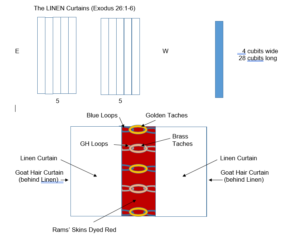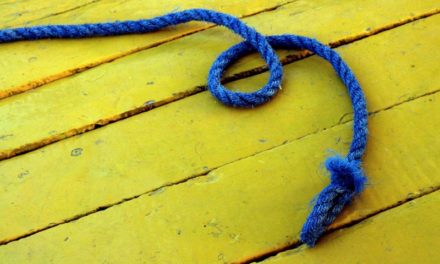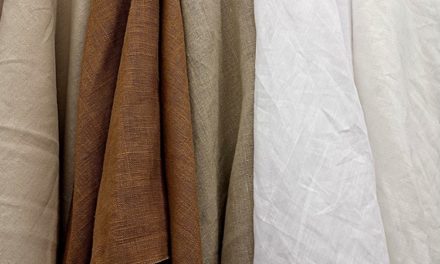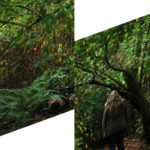THE BLOOD-RED LINE
In the first fourteen verses of Exodus 26 Moses identifies a blood-red line in the Tabernacle… over 45 feet long. Did you miss it?
Within those fourteen verses we learn something else about that line:
- It involves Christ’s human and divine natures—how they blend, but remain separate
- It is the final part of a countdown… yet connects with the future
- It is involved with Redemption and obedience
- It is red because of something unexpected
In this part we will look at the verses closely, for they not only determine where the line is but also give the details needed to put a date on the line.
VERSE 1: Moreover thou shalt make the [a] tabernacle with [b] ten [c] curtains of [d] fine twined linen, and [e] blue, and purple, and scarlet: with [f] cherubims of [g] cunning work shalt thou make them.
[a] This is talking about the tabernacle (in contrast to the sanctuary). The tabernacle focuses on the building the sanctuary is in (Numbers 10:21). Christ identified His BODY with the tabernacle, or temple (John 2:19,21). In the New Earth, after sin is taken care of, there will be no temple, for the Father (Lord God Almighty) and His Son (the Lamb) are its temple (Rev 21:22).
[b] The number 10 is used to express God’s blessing in our lives in various areas. In Hebrew the word means (Strong’s Concordance) “as an accumulation to the extent of the digits.” In Malachi 3:10 God lets us know that this accumulation is because He has partnered with us to get it. And His part is only 1/10th. But to those who are faithful in returning to Him His due, God promises to bless them even beyond their capacity to receive. So we can assume the ten linen curtains have something to do with God’s involvement in our life, and if we are faithful in partnering with Him and returning to Him His own, we will be abundantly blessed beyond our wildest expectations. This number (10) is also an integral part of the covenant God established with Abraham, and we’ll see it several more times in the sanctuary, and, though applied in different ways, it will always carry this basic meaning.
[c] These “curtains” are set apart from the first two coverings of the tabernacle (Numbers 4:25), because the intent for them is not for protection from the elements (as will be obvious as we read through these verses). The word in Hebrew used to describe them adds the idea of “tremulous” (root word from which it is taken means “to be broken up, as with a violent action, to fear).
[d] The phrase “fine linen” is used in Revelation 19:8 to represent the righteousness of saints. “Fine linen,” in the Hebrew also adds the characteristic of being made white by bleaching. In other words, it was a white that was not natural to the linen fabric. It was white only because an outside action acted on it to make it so.
[e] Two of these three colors, purple and scarlet, transport us completely past all the rest of the Bible only to land directly on the harlot of Revelation 17 and 18. She wears the “fine linen” along with purple and scarlet. Blue, which is missing on the harlot, is used elsewhere to represent obedience and loyalty to God’s Law (Numbers 15:38-40).
[f] Obviously the tabernacle is representing the heavenly (in contrast to the courtyard representing the earthly) since angels are pictured everywhere. Their being “woven in” with the other colors (see [g]) speaks strongly that the linen here, representing the person of Christ, is speaking of His divinity, whom angels give willing service.
[g] This is the first time the three colors and linen are described being united this way (cunning = to inter penetrate, weave). These colors, when mentioned in the courtyard, are described as being embroidered. The difference is the latter needs a finished material in order to add the colors. In other words, if Christ is the Door (), He is speaking being so only after His death and resurrection. However, in the tabernacle, whatever royal standing those colors imply are part of His nature, as the linen fabric portrays.
VERSE 2: The length of one curtain shall be [a] eight and twenty cubits, and the breadth of one curtain [b] four cubits: and every one of the curtains shall have [c] one measure.
[a] This is the only place in the Bible where this number (28) shows up, so we cannot connect it with anything else. If we are to make sense out of it, the only other way is to consider the multiples that make it up. We could use 2 X 14 or 2 X 2 X 7 or 4 X 7. After doing a little research it appears the numbers 4 and 7 make a couplet God favors more than the other combinations (Matthew 16:10; Revelation 5:6; 15:7; 4th commandment concerning the 7th day Sabbath). We will see this combo again as we delve further into the sanctuary.
[b] This number is used a lot in the Bible, but to keep our study focused here and simple, let’s just keep this number in mind and see how it is played out, especially considering [a] above.
[c] God is making the point that each linen curtain is to have the exact same width of panel, or section of the larger curtain.
VERSE 3: The [a] five curtains shall be [b] coupled together one to another; and [c] other five curtains shall be coupled one to another.
[a] [c] These verses are making it very clear that the linen curtain that is composed of 10 panels (or curtains) is to be divided in half, making two separate sections of 5 panels each. The purpose for this will be made more clear later. But it does have a curious parallel with the covenant God made with Abraham (before his name change), that was consummated the night a smoking furnace and burning lamp passed through three animals Abram was to cut in half and spread apart, laying each half opposite one another (Genesis 15:10,17-18). More on this later.
[b] “Coupled here simply means “to join.” God appears to be making a point that these two sections of curtains must contain 5 panels, exactly the same width and length, and then joined together as one. We’’ see the purpose for this later.
VERSE 4: And thou shalt make [a] loops of [b] blue upon the [c] edge of the one curtain from the selvedge in the coupling; and [d] likewise shalt thou make in the uttermost edge of another curtain, in the coupling of the second.
[a] The Bible speaks of loops only in Exodus, concerning the curtains, but in 36:12 Moses makes clear their purpose, to hold one curtain [section] to another.
[b] Note the color blue is used here, with no comment. It’s up to the reader to delve into its purpose for being there. At this time, however, it would be premature to venture valuable time on guesses, since more information is still coming in. All we know at this point is that obedience to God’s Word is involved.
[c] The loops were to be placed across from each other where the two sections meet. This would only make sense, but it does have a prophetic purpose as well, which we will discuss at another time.
[d] Again, we see the need to have the two halves mirror copies of each other. We’ll see why later.
VERSE 5: [a] Fifty loops shalt thou make in the one curtain, and fifty loops shalt thou make in the edge of the curtain that is in the coupling of the second; [b] that the loops may take hold one of another.
[a] Here we have introduced a new number to consider. This is a number that is used throughout Scriptures for various purposes, but they all have a common factor. DELIVERANCE: the width of the ark (Gen 6:15), the number Abraham began with in his interceding for the “righteous” living in Sodom (Gen 18:28), breadth of courtyard (Exo. 27:12), the year of Jubilee, when liberty to all is given (Lev 25:10), the Feast of Pentecost, a celebration of thanksgiving and blessing, was celebrated 50 days after Passover (Lev 23:15; 3SP 265) –the Holy Spirit was poured out during this time (Acts 2:1), retirement age from service in sanctuary (Num 8:25), redemption price for laying with a virgin (Deut 22:29), purchase price for property used to build an altar to stay a plague (2Sa 24:24), Number of prophets Obadiah hid per cave from Jezebel’s wrath (1Ki 18:4). So, unless we are giving a better reason to assign to this number, at this point we will assume it has something to do with REDEMPTION, DELIVERANCE, and the GRATEFULNESS and thanksgiving that should accompany it.
[b] Again, it is made clear that the loops are to be opposite to each other, that “one may take hold of the other.” This emphasis will become clear later, when we consider its prophetic implications.
VERSE 6: And thou shalt make fifty [a] taches of [b] gold, and [c] couple the curtains together with the taches: and [d] it shall be one tabernacle.
[a] Taches are knobs or belaying pins used to connect the two loops together. They were made to easily disconnect as well, since that would be necessary when the tabernacle needed to be disassembled for moving. Again, these are accessories mentioned only in relation to the tabernacle.
[b] Gold is the most valuable material used in the sanctuary and indicates the purpose for these pins was significant. Also we need to keep in mind that we are considering Christ’s divine nature at this point, so we could easily assign a divine characteristic here: (Psalm 19:9-11) the judgments of God, (1Pet 1:7) faith, (Proverbs 16:16) wisdom, or just superiority or preeminence (Dan 2:38).
[c] The purpose of the taches is made clear, to couple the two sections of curtains together.
[d] Making it one. In other words, all these panes joined together, all these loops, and all these taches, are all an expression of a singular point. Exactly what that is we cannot say for sure at this point. But we must keep this thought in mind.
VERSE 7: And thou shalt make [a] curtains of [b] goats’ hair to be a [c] covering upon the tabernacle: [d] eleven curtains shalt thou make.
[a] The same word used for the linen is used here, so they have similar purposes.
[b] This is a sacrificial animal that, at times, can be substituted for lambs in animal sacrifices (Lev 5:6)
[c] Now this is significant! The word “covering” used here is unique to the goat’s hair curtain. It is not the same word used for the first two layers that are used for protection (verse14). This word means “tent” (as clearly conspicuous from a distance). In other words, it is this covering that will give the tabernacle its identity, as clearly conspicuous from a distance. And it does not do this as a protector (which the first two coverings provide), but rather because of something else. It portrays the human nature of the Messiah, the part that can suffer and die (as goats do in a sacrifice).
[d] God uses this number for His purposes as well as other numbers, but it is usually associated with something very uncomfortable. Here are some examples: the men of Israel war against the tribe of Benjamin (Judges 20-21), Jacob’s awful night of wrestling came when he had eleven sons (Gen 32:22), Jacob got in trouble with his dream of 11 stars bowing down to him (Gen 37:9), The children of Israel were only 11 days from the Promised land but wandered in the desert for 40 years, because of insubordination (Deu 1:2), Delilah was bribed to get Samson’s secret for eleven hundred pieces of silver (Judges 16:5), a man from mount Ephraim recaptured eleven hundred pieces of silver that was taken from his mother and she used a portion of it to make her son a graven image and a molten image (Judges 17:1-6), all the kings that reigned 11 years were bad, all went well with the man who hired people at different hours of the day, until the eleventh hour (Matt 20:6-15), the 11 disciples felt they needed to replace the spot Judas left (Acts 1). So the 11 panels of goat hair, suggest something either uncomfortable or temporary.
VERSE 8: The length of one curtain shall be [a] thirty cubits, and the breadth of one curtain [b] four cubits: and the eleven curtains shall be all of [c] one measure.
[a] 30, when used alone (not as part of a larger number), it is related to “coming of age,” maturity, readiness to take on serious assignments. This was the case with Joseph (Gen 41:46), Jesus (Luke 3:23), and the priests who were assigned special duties (Num 4:43). And since length is often used as a measurement of time, and the goat hair curtain represents Christ’s Messiahship in human form, it highly suggests the age at which He would begin that ministry.
[b] Note these panels were to be identical in width as the linen panels. You will see why later.
[c] Again God is very clear that all the panels are to be identical in width and length.
VERSE 9: And thou shalt [a] couple five curtains by themselves, and [b] six curtains by themselves, and shalt [c] double the [d] sixth curtain in the [e] forefront of the tabernacle.
[a] As with the linen curtains, 5 panels shall be joined together (the ones that will cover the Most Holy Place).
[b] But the eastern section will have an extra one.
[c] One of these panels is to be doubled over (in half)
[d] Is called the sixth panel or section. This defines a COUNTDOWN from wherever the panel is to where that section of the curtain ends (at the taches).
[e] The sixth panel is to hang out into the courtyard! This defines all that the Messiah will be doing while on this earth in human form (prior to His returning to the heavenly tabernacle to continue His ministries for us). We will be studying the significance of the doubling and hanging out into the courtyard when we study 1844 in the design of the sanctuary.
VERSE 10: And thou shalt make [a] fifty loops on the edge of the one curtain that is outmost in the coupling, and fifty loops in the edge of the curtain which coupleth the second.
[a] Note the similarity and position in the number of loops with the linen curtain. We see that God intended both of these curtains to work together. But the material to make these loops are not specified, so obedience to the Law is not a characteristic here.
VERSE 11: And thou shalt make [a] fifty taches of [b] brass, and put the taches into the loops, and couple the tent together, that it may be one.
[a] Again, repeating the instructions exactly as for the linen curtains.
[b] Brass is a metal that must be made by man (copper plus zinc usually), so it is another indicator that this curtain addresses the human nature (as portrayed on this earth).
VERSE 12: And the [a] remnant that remaineth of the curtains of the tent, the half curtain that remaineth, shall [b] hang over the backside of the tabernacle.
[a] This is speaking about the 5-panel goat hair section that covers the Most Holy. Since that portion is only ten cubits long (from East to West), and the 5-panel section is 20 cubits (5 X 4 cubits wide), only ½ of the curtain is needed to cover the Most Holy Place ceiling. The number ½ is a covenant number, remember.
[b] The last ten cubits will hang over the backside, and this is called a “remnant.” Interesting that that word is used at this time, which coincides with the final portion of completing the covenant before Jesus returns, and also describes those who remain faithful to God during the hardest of times. (Rom 11:5, Rev 12:17).
VERSE 13: And a [a] cubit on the one side, and a cubit on the other side of that which remaineth in the length of the curtains of the [b] tent, it shall hang over the sides of the tabernacle on this side and on that side, to cover it.
[a] This is referring to the difference between the goat hair curtain with 30 cubit-long panels, and the linen one with 28 cubit-long panels. The goat hair ones will extend beyond them another cubit to finish covering the tabernacle.
[b] This is reminding us that his particular covering is what the tabernacle (the body of Jesus) will be identified with—not the fine linen or even badgers’ skins.
VERSE 14: And thou shalt make a [a] covering for the [b] tent of [c] rams’ skins [d] dyed [e] red, and a covering above of [f] badgers’ skins.
[a] The word used for these last two (or really first two) skins carries the idea of weathering. The goat hair curtain does not have this association.
[b] The rams’ skins is to cover the “tent” (the tabernacle’s identity). It’s the one on top. This point is made clear for determining the red line.
[c] The ram is known for his strength, and is never used as an offering when it is still young (as were sheep and goats), for it would not be strong then.
[d] This is a critical characteristic. The color given the skins is not natural to the ram. It is, you might say, UNEXPECTED. Whatever the red line portrays will have the element of surprise in it, involving something not expected.
[e] This color is an attention-getting color, for it is blood-red. It is associated with blood (Isa 1:18, 2Ki 3:22), persecution (Rev 6:4), and Satan in the form of a great red dragon at the end of time (Rev 12:3)
[f] Or seal skins, for weather-proofing the tabernacle. It was a dark-skinned creature and would not draw attention as would the fine linen of the courtyard surrounds.
Putting this all together, we see, as we look up to the ceiling directly above the vail that separates the Holy from the Most Holy Places, a blood-red line as a backdrop to the various groups of 50 loops and taches. Here’s a sketch about how it could look:

That line would go from South to North. Though it would also go on the OUTSIDE of the two walls, when the priest was at the Altar of Incense just in front of the vail, he would see reflected on the walls the red line in the ceiling, giving the appearance of the blood painted on the doorposts and lintel of the Hebrew homes the night of the Passover. This, of course, was a prophecy of the Lamb giving His life on a future Passover, empowering the incense placed on the altar to be mixed with the people’s prayers.





